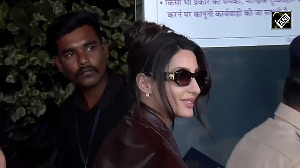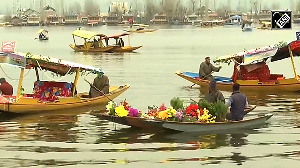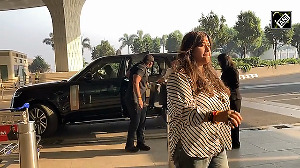Tears are not what one would normally associate with Maha Vir Chakra recipient Brigadier (Retd) Kailash Prasad 'Tom' Pande, who was former prime minister Atal Bihari Vajpayee's classmate at Gwalior's Victoria College and was part of undivided India's Regiment of Artillery in which Pakistan President Pervez Musharraf was also enlisted much later.
However, the 81-year-old veteran -- who fought in every declared war (the Kargil conflict being an exception as it was accorded a separate status) in the history of free India and was also an infantry commander -- revealed the affection of an officer for his men when he wept silently while remembering the jawans who were martyred before his eyes in the battles of Mynamati and Dhalai during the 1971 Indo-Pak conflict -- whose anniversary 'Vijay Diwas' is observed on December 16.
"I feel emotional when I talk of my men, as 95 personnel were lost at Mynamati and 45 at Dhalai. I was wounded and fought for a week with my leg dangling," Brig Pande told UNI at his Idgah Hills bungalow in Madhya Pradesh capital Bhopal.
Among the trophies in the living room are the epaulettes of Brig Mohammad Atif, Sitar-e-Pakistan and Commander of Mynamati, who surrendered on December 17.
Operation Cactus Lily began on December 3, 1971 but the veteran's brigade was in East Pakistan (now Bangladesh) from May 1971 to May 1972.
"The official 13-day war actually stretched for 13 months during which I fought 18 battles, killed and captured a number of people. Though the Indian Army officially withdrew on March 13, 1972, I was helping the Bangladesh government in the Chittagong hill tracts for three more months," Brig Pande narrated.
The MVC citation said that the brigadier's 61 Mountain Brigade Group was assigned the task of clearing a well-fortified position in the eastern sector in December, 1971. The task was successfully completed mainly due to his inspiring leadership.
'He was always well-forward, unmindful of his safety, encouraging troops and directing the battle,' it read.
The brigade group advanced 40 miles in 72 hours, effectively bottling up the enemy and capturing key posts. When lodgement was attained in the fortress of Mynamati defences, the brigade was subjected to determined enemy attacks supported by tanks. Against all the relentless pressure, the brigade held on to the defences until the surrender of the enemy commander.
'Throughout the operations, Brig Pande displayed gallantry, leadership and devotion to duty of a very high order,' the citation noted.
At the bottom is the Gurkha maxim: 'It is better to die than to be a coward.'
Casualties mounted when an enemy tank began firing on the Indian infantry but a couple of MiGs returning from a sortie proved a godsend and were radioed for support.
"They had only a rocket each left. Though the first plane missed, the second one got the tank. Eventually, the flag of Mynamati was handed over to me. More than 5,000 troops and about 50 officers surrendered. I got the flag framed and handed it over to the Artillery Museum," Brig Pande explained.
The perils of war were revealed when the veteran spoke of crossing the Gomti river in the darkness in local boats, the inaccuracy of maps and about the day his troops opened fire on his jeep mistaking him for the enemy.
"Some bullets hit the vehicle but I was saved," he said.
Forty-one prisoners of war whom he handed over to East Pakistan's Mukti Bahini (Liberation Army) were shot dead by the latter.
Born on July 4, 1925 in Gwalior, Brig Pande -- a fellow of the Royal Geographical Society -- was commissioned in 1944. His son and son-in-law are also in the Indian Army. The latter officer is of the rank of lieutenant-general.






 © 2025
© 2025